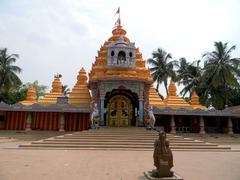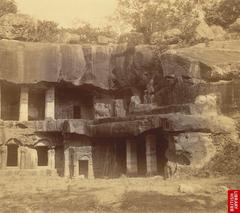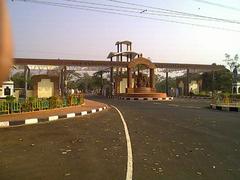Kapilesvara Siva Temple: Visiting Hours, Tickets & Bhubaneswar Historical Sites Guide
Date: 15/06/2025
Introduction
Set within the temple-rich city of Bhubaneswar, the Kapilesvara Siva Temple stands as a remarkable testament to Odisha’s ancient spiritual legacy and architectural expertise. Built in the 14th century and dedicated to Lord Shiva, this shrine is celebrated for its refined Kalinga architecture—characterized by the iconic rekha deul (curvilinear spire) and pidha deul (pyramidal roof). Beyond its architectural beauty, the temple is revered for its deep religious significance, legendary associations with sage Kapila Muni, and its role as a vibrant community hub.
Visitors and devotees are drawn to its tranquil atmosphere, ritualistic worship, and the sacred Kapila Kunda pond—believed to possess purifying powers. This guide offers a comprehensive overview for travelers, pilgrims, and history lovers alike, encompassing the temple’s historical and cultural context, architectural highlights, restoration efforts, visiting hours, ticket information, and nearby attractions. To further enrich your experience, authoritative resources like Odisha Tourism and the Archaeological Survey of India Bhubaneswar Circle provide essential visitor insights and updates.
Table of Contents
- Origins and Historical Context
- Architectural Evolution and Features
- Legends and Spiritual Significance
- Religious and Community Life
- Visiting Hours & Ticket Information
- Accessibility & Travel Tips
- Nearby Attractions
- Preservation & National Importance
- Community Involvement
- Frequently Asked Questions (FAQ)
- Visitor Recommendations & Summary
- Sources & Official Links
Origins and Historical Context
Kapilesvara Siva Temple is located about 6 km south of central Bhubaneswar in the village of Kapileswar. Constructed during the reign of the Ganga dynasty in the 14th century CE, the temple is an outstanding example of the Kalinga architectural style (Odisha Tourism; ASI Bhubaneswar Circle). The temple complex reflects both the religious fervor and the architectural ingenuity of its era, with later additions such as pillared mandapas and the sacred Kapila Kunda pond expanding its original layout.
Architectural Evolution and Features
The temple’s architecture is marked by its soaring vimana (sanctum tower) in rekha deul style, intricately carved jagamohana (assembly hall), and later additions like the nata-mandira (festival hall) and bhoga-mandapa (offering hall). The original sanctum and main spire date back to the 14th century, while subsequent renovations have preserved and enhanced the temple’s structural and artistic integrity (Indian Heritage; Tusk Travel).
Key features include:
- Vimana: Curvilinear spire rising approximately 11.4 meters, symbolizing spiritual ascent.
- Jagamohana: Assembly hall with stepped roof and richly carved walls.
- Sculptural Ornamentation: Doorjambs with Gajalakshmi motifs, river goddesses, Saivite guardians, and depictions of mythological scenes (Temples of India).
The temple precinct encompasses 33 subsidiary monuments, including the Bhandara Ghara shrine and sacred tanks like Manikarnika and Kapila Kunda (Trek Zone).
Legends and Spiritual Significance
According to local tradition, sage Kapila Muni undertook penance at this site, where Lord Shiva manifested as a lingam—giving rise to the temple’s name, Kapilesvara, or “Lord of Kapila.” The adjacent Kapila Kunda pond is believed to have been created by the sage and is still used for ritual purification by devotees (orissaguide.com). This association enhances the temple’s status as both a spiritual and philosophical landmark.
Religious and Community Life
The temple remains a bustling center of Shaivite worship, especially during Maha Shivaratri, Kartik Purnima, and Shravan Mondays, when it is adorned with lights, flowers, and echoes with devotional music (incredibleindia.org). Daily rituals include abhisheka (ritual bathing), arati (lamp waving), and offerings of water, milk, and flowers. The temple’s role extends to hosting charitable activities, community feasts, and cultural performances, reinforcing its status as a social and religious nucleus (orissaguide.com).
Visiting Hours & Ticket Information
- Opening Hours: Daily from 6:00 AM to 8:00 PM.
- Entry Fee: Free for all visitors. Special pujas or guided tours may have nominal fees.
- Photography: Allowed in designated areas; permits may be required for professional photography.
Accessibility & Travel Tips
- Wheelchair Access: Main precinct is wheelchair accessible, though some traditional stone flooring may pose challenges.
- Dress Code: Modest attire is recommended as the temple is an active place of worship.
- Guided Tours: Available through local agencies or by arrangement with temple authorities.
- Getting There: Easily accessible by taxi, auto-rickshaw, or public buses from Bhubaneswar city center. Nearest airport: Biju Patnaik International Airport (~5 km); Bhubaneswar Railway Station (~3 km).
Travel Tips:
- Visit during early morning or late afternoon for a serene atmosphere.
- Wear comfortable footwear due to uneven stone surfaces.
- Check festival schedules for a more vibrant experience.
Nearby Attractions
Enhance your Bhubaneswar itinerary by visiting other prominent historical sites:
- Lingaraj Temple: The city’s most iconic temple, renowned for its grand scale.
- Mukteswara Temple: Celebrated for its ornate torana (arched gateway).
- Brahmeswara Temple & Rajarani Temple: Noted for sculptural details and unique architecture (Hello Travel).
Preservation & National Importance
The Kapilesvara Siva Temple is designated as a protected monument by the Archaeological Survey of India (ASI), ensuring regular conservation, documentation, and restoration using traditional methods. Efforts focus on structural stability, preservation of carvings, and sustainable visitor management. The temple is recognized under the Ancient Monuments and Archaeological Sites and Remains Act, 1958, and is included in national heritage tourism initiatives (Times of India).
Conservation Challenges: Urban encroachment, pollution, and high visitor footfall necessitate ongoing monitoring and community engagement.
Community Involvement
Local temple trusts, priests, and artisans play a crucial role in daily maintenance, festival organization, and heritage education. Community-driven initiatives—such as cultural workshops, charity events, and art preservation—foster collective stewardship and ensure the continuity of religious and cultural traditions (orissaguide.com).
Frequently Asked Questions (FAQ)
Q1: What are the visiting hours of Kapilesvara Siva Temple?
A1: The temple is open daily from 6:00 AM to 8:00 PM.
Q2: Is there an entry fee?
A2: No, entry is free for all visitors; special activities may have a nominal fee.
Q3: Is the temple accessible to differently-abled visitors?
A3: Yes, with ramps and accessible pathways in the main precinct.
Q4: How do I arrange for a guided tour?
A4: Guided tours can be booked at the temple office or via local travel agencies.
Q5: Can I take photographs inside the temple?
A5: Photography is permitted in certain areas; videography may require prior permission.
Q6: When is the best time to visit?
A6: October to March is ideal for pleasant weather and festival experiences.
Visitor Recommendations & Summary
The Kapilesvara Siva Temple exemplifies the intersection of spiritual devotion, architectural mastery, and living cultural heritage in Odisha. Its intricate Kalinga-style spires, rich legends, and vibrant festivals make it a must-visit for those exploring Bhubaneswar’s temple corridor. Ongoing conservation by the ASI and community stakeholders ensures the site remains accessible and meaningful for generations to come.
For a seamless and enriching visit:
- Review visiting hours and plan for early or late day trips.
- Dress respectfully and be mindful of ongoing rituals.
- Explore nearby temples for a comprehensive heritage experience.
- Utilize resources like the Audiala app and official tourism portals for up-to-date information and guided audio tours.
Sources and Official Links
- Odisha Tourism – Kapilesvara Siva Temple
- ASI Bhubaneswar Circle – Kapilesvara Siva Temple
- Orissa Guide – Kapilesvara Siva Temple
- Incredible India – Kapilesvara Temple
- Tusk Travel – Kapilesvara Siva Temple Odisha
- Trek Zone – Kapilesvara Siva Temple
- Temples of India – Kapileswar Temple
- Times of India – National Importance Declaration
- ASI Official Website
- Bhubaneswar Tourism
For the most immersive experience, explore available virtual tours and downloadable maps on the above official sites.








